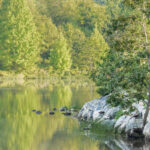Are you looking for a community of like-minded readers that enjoy science and nature books? Then join the Black Hill Discovery Center Bookworms! Our book discussion group meets in-person every fourth Thursday of the month, March through October. Books will focus on environmental, conservation, and nature-related topics including non-fiction and fiction titles. Group members will have the chance to help select future books. Please register for each discussion you plan to attend so that we can contact you ahead of the meet-up. Please feel free to bring dinner or snacks with you to have during the discussion. All selected books are available through the Montgomery County Public Library. If you need help finding a copy to read or have any questions, please contact Christy.Korzen@MontgomeryParks.org.
The book for June is “The Backyard Bird Chronicles” by Amy Tan.
